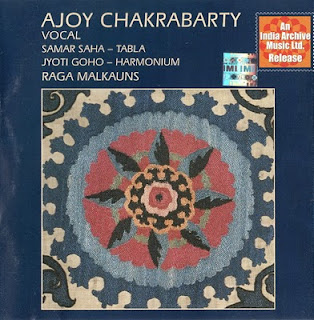two new sections in this Archive for Third Ear Band's (lazy) addicts.
November 09, 2010
Shipping forecast.
Ladies & Gentlemen,
two new sections in this Archive for Third Ear Band's (lazy) addicts.
two new sections in this Archive for Third Ear Band's (lazy) addicts.
On the column at right you can find a section with TEB rare tracks ("Raga n. 1", "Raga in D", "Ghoo"...) for a more rapid free downloading.
Below of it, you can find another new section (titled "The Raga bums") with rare Indian ragas (in MP3 format) for free downloading - great executions by monsters as Lalgudy G. Jayaraman, Ajoy Chakrabarty, Ali Akbar Kan or Ustad Zakir Hussain...
So enjoy the great Indian tradition that inspired the Thirds in a period when the Indian music in Western was just the sitar played in a Beatles' album...
no©2010 Luca Ferrari
Edited by
Luca Chino Ferrari
Subscribe to:
Post Comments (Atom)

































































Intersting to note that the Third Ear Band didn't start using Eastern modes until they teamed up with the more New Age / World Music stylings of Lynn Dobson. Prior to that their modes were very much Western, drawing on a diversity of (for want of a better word) folk influences. Minns spoke of the inspiration of certain bagpiping traditions on his playing - fusing these with the pure improvisation and atonality deriving from the Western classical tradition in which Coff, Minns & Smith especially were well versed - a tradition which includes Medieval music which flavours not only Abelarde & Heloise and Macbeth, but rest of their ouvre as well. As for Jazz, there is a quote from Evan Parker of how at a gig of free-jazz at the ICA Glen turned to him and said "Jazz is dead and we are its pall-bearers." I think that's in the Wrong Movements Robert Wyatt book somewhere - I'll check it out later.
ReplyDeleteGlen's genius was to somehow act as a shamanic catalyst for the alchemical transfigurations of the band resulting in some of the most astonishing music ever realised. In the hip-speak of the time, raga becomes something very different to its very strict sense in Indian Classical Music. In the Third Ear sense 'raga' combines organic improvisation and rhythmic modality - what Glen referred to as 'Free Raga'. I've heard it said that Coltrane's 'My Favourite Things' was often mistaken for a raga - certainly there a lot of Coltrane in Minns' playing, and when Sun Ra employs the oboe (as on Lanquidity) we hear Paul feeding back from 'out there'. Ragas aside, other such classical traditions of modal improvisation include the Piobaireachd of the Scottish Highland Bagpipe which has definate Third Ear flavours too - open variation & extended durations, and fingering ornamentation that remind us of Paul Minns at his most florid! But when the Third Ear Band are at their most melodically modal (Jason's Trip, Ghetto Raga, Stone Circle, Earth, Water etc.) their flavours are Western rather than Eastern, and born of a tenser dialectic accordingly.
Very interesting, Sean... I have to admit my waste lacunas about it... But tell me: is this your essay on the band's music or just a preview of it?
ReplyDeletePreview!
ReplyDeleteIt occurs to me that Minns, Coff & Smith were very much of the Western Classical Tradition & it's this that gives the music its unique flavour. In the later band with Dobson, Carter & Black, the rock & jazz influences come to the fore. I think the live recordings of this band are pretty amazing, but of a different order to what we hear on, say, Abelarde & Heloise which is so deep I'm still hearing it...
Yes, I'm totally agreed with you. In the TEB first era the suggestions are deep in Western classical & folk music, even if, as the same Minns stated in his essay, also (in same tracks) in Estern Indian tradition... Anyway we cannot ignore that, apart Glen, the other musicians had been educated by classical music studies, with a specific approach to the instruments... The amazing thing about the band, is my opinion, is infact that incredible, unique syncretic flavour of various references, fitted for a peculiar musical form never reached by other experiences...
ReplyDelete